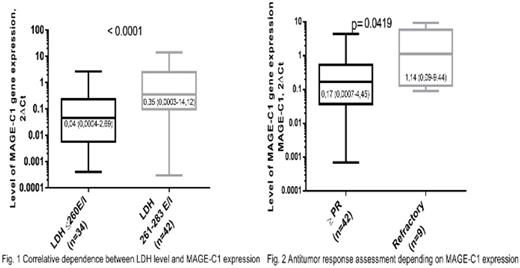Abstract
Introduction. The group of genes, encoding cancer-testis antigens is actively studied as a new markers of refractory in some diseases, including multiple myeloma (MM). It is suggested that the MAGE-C1 gene in MM may be considered as an additional marker predicting the effectiveness of therapy.
Purpose. Determine of MAGE-C1 gene expression by quantitative real-time polymerase chain reaction (qRT-PCR) in MM patients and assess the correlation of expression with some laboratory parameters and response on bortezomib-containing therapy.
Patients and methods. A prospective study from February 2019 to July 2021 included 76 MM patients (43 men and 33 women) aged 35 to 82 years (median 58). The level of MAGE-C1 gene expression by qPCR-PCR in bone marrow samples, enriched with CD138+ cells, was determined for all patients. Quantity of MAGE-C1 expression was calculated with 2ΔCt method relative to housekeeping gene expression. Plasma cell content ranged from 1 to 89% (median 26%), monoclonal paraprotein secretion vary from 2.1 to 82.1 g/l, Bence-Jones protein in urine (from trace values to 12.54 g/day) was determined in 50 patients. High - risk cytogenetic [t(4; 14)(p16; q32), del17p] was documented in 22 patients, bone plasmocytomas - in 36 patients, myeloma nephropathy - in 17. All patients recieved induction with bortezomib - containing courses. Median follow-up duration: 14 months (1-22 months). As a control, similar bone marrow cells of 7 healthy donors were investigated.
Results. The average value of MAGE-C1 expression in donors was 0.01 ± 0.007, a range of values vary from 0.0003 to 0.06. Gene expression MAGE-C1 index > 0.06 is accepted as increased expression. High serum lactate dehydrogenase (LDH) level (higher than the upper limit of reference values) was observed in patients with high MAGE-C1 gene expression [median - 0.35], normal LDH-level (≤ 260 U/L) was observed in patients with lower MAGE-C1 gene expression [median - 0.04]; p < 0.0001 (Figure 1). Negative correlation was found between the content of hemoglobin (Hb) and level of MAGE-C1 expression: Hb ≥ 12.0 g/dl was observed in patients with increased MAGE-C1 expression [median - 0.27], and Hb 5.5-11.8 g/dl - in patients with lower expression indices [median 0.1]; p=0,034.
Antitumor response was evaluated after induction therapy in 51 patients. In 100% of patients with MAGE-C1 expression of ≤ 0.06 ≥ partial response (PR) was achieved, while in patients with MAGE-C1 expression of 0.07-1.0 ≥ PR was achieved in 84.6% of cases, and in patients with MAGE-C1 expression of > 1.0 - in 58%; p > 0.05. Besides, patients with ≥ PR had a level of MAGE-C1 expression lower than patients with a refractory to bortezomib [median 0.17 vs 1.14]; p = 0.04 (Figure 2).
Conclusions. High MAGE-C1 gene expression in MM patients is associated with an increase in LDH, which corresponds to stage III by R-ISS. Probability of achievement of the antitumor response ≥ PR on the bortezomib-containing induction is reliable above at patients with low MAGE-C1 expression while the hyperexpression of this gene is followed by a refractory to a bortezomib therapy. Further study of MAGE-C1 gene expression may promote a personalized approach in the choice of antitumor therapy.
No relevant conflicts of interest to declare.


This feature is available to Subscribers Only
Sign In or Create an Account Close Modal